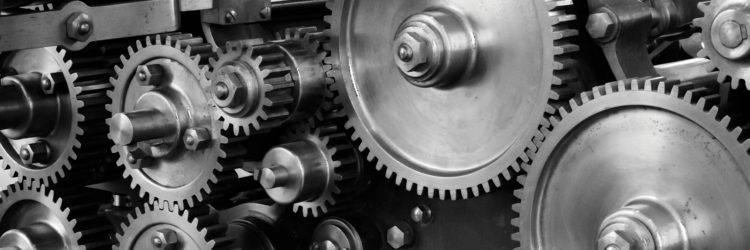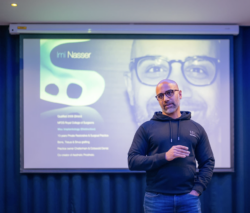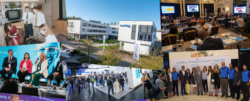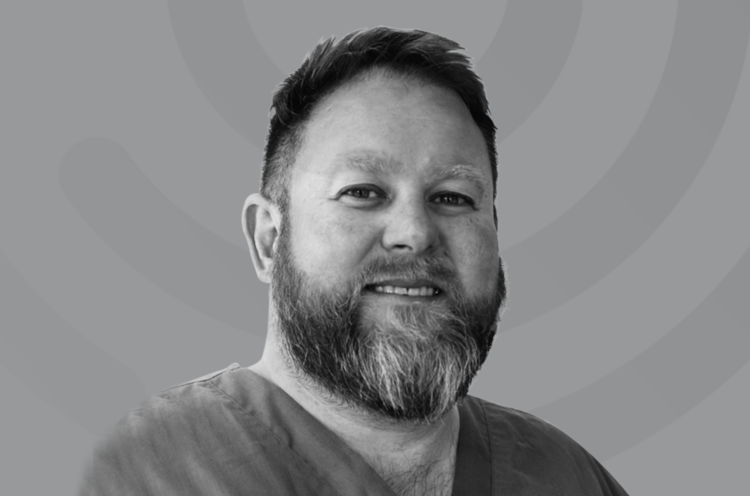Man vs. Machine – guided and non-guided approach in implantology

Christian Mehl presents a guided and non-guided approach to implant dentistry
Due to the rapid development of supporting software programmes in all areas of dentistry and ever new possibilities to link the analogue with the digital world, there are now incredible treatment and planning options. The shift from the actual treatment at the dentist’s chair to digitally pre-planning treatments requires increasing knowledge of software programmes and especially their interfaces with one another from the dentist. But not only is the dentist’s profession changing fast, the level of knowledge demanded from dental technicians has also increased drastically.
This article hopes to create some curiosity about this change with a little glimpse into the emerging world of digitalised implant dentistry.
Introduction
Poor long-term survival rates and the wish of many patients to receive fixed teeth mean removable solutions appear as a second-choice therapy [1]. Nevertheless, especially when multiple teeth are lost, removable dentures are often chosen due to financial limitations. The resulting restoration is often unsatisfactory for functional, aesthetical and phonetical reasons [1-3]. Even carefully manufactured telescopic dentures on natural teeth may lose their function if the telescope-supporting abutment teeth are lost because of overloading, periodontitis or decay [1].
This article shows the surgical, prosthetic and laboratory procedure of two comprehensive rehabilitations with fixed screw retained bridges and discusses alternatives as well as advantages and disadvantages of this method. Particular attention is paid to the comparison of guided and non-guided implantation. To keep this article as concise as possible, the authors do not want to present a comprehensive literature research in the introduction, but instead refer to the relevant literature [4] and the discussion below. With this article, we want to show at what amazing speed digitalisation has changed dentistry and what incredibly exciting possibilities there are today.
Case Report 1 – Non-Guided Surgery
The 66-year-old male patient presented himself to our clinic in 2020. The general medical history was without any pathological findings. According to the patient, the dentures he was wearing were over 30 years old (Figure 1a-f). After the initial diagnosis (Figure 2a and b), and ethical consideration of the necessary extractions and discussion of all possible treatment options, it was decided to restore his lower with endodontic treatments of teeth 33 and 36, two tooth-supported bridges and one implant-supported bridge (Figure 3).
The option decided on for the upper jaw was to remove all the remaining teeth and restore function and aesthetics with a screw retained bridge on four implants (Camlog® Comfour® Concept; Figure 3). Together with the patient we decided that the majority of the treatment should be carried out under deep sedation. Prior to the operation, a cone beam computer tomography (CBCT; Figure 4), a digital scan of the teeth and a photo status were recorded to plan the operation. The collected data was then used in three ways:
- The digital implant planning by the dentist
- The idealised digital framework for the smile of the patient (“Smile Design”)
- The transfer of the digital data from 1. and 2. into the analogue world by the dental technician (models, drilling template, preparation of the temporaries)
The implant planning was carried out with a software programme (SMOP, Swissmeda, Baar, Switzerland, Figure 5a and b). The digital set-up made by the dentist as a guideline for the dental technician was also designed by a software programme (SmileCloud, SmileCloud Biometrics; Figure 6a-c). The final situation we wanted to achieve was created with another digital set-up done by the dental technician (Smile Design, Amann-Girrbach, Pforzheim, Germany; Figure 7a-i). After the finalised digital planning had been accepted by the dentist, the models were then printed (3-D Medical Print, Lenzing, Austria; Figures 8a-8e), and the temporary was milled in the in-house laboratory from tooth-coloured PMMA (Figures 8f and g). An implantation with a guided drilling template was originally planned, but due to postal difficulties, the PMMA temporary had to be duplicated as a drilling template at short notice. Endodontic pre-treatment of the teeth 33 and 36 was performed in a separate appointment prior to the operation.
During a five-and-a-half-hour operation under deep sedation, the remaining teeth in the upper jaw were completely removed. In the lower jaw, teeth 33, 32, 43, 44, 46 and 48 were prepared for the temporary and tooth 42 was extracted. Mucoperiosteal flaps were then prepared in the upper and lower jaw and, following the marking of the implant position, the implant cavities were drilled freehand using a drilling template (the duplicated PMMA temporary). After inserting the implants (Camlog® PROGRESSIVE-LINE, Camlog, Basel, Switzerland) with a torque between 50-70 Ncm, a mesostructure was screwed into the implants with 20 Ncm. The extraction sockets were filled or covered with xenogeneic bone of bovine origin (BioOss, Geistlich, Baden-Baden, Germany) and membranes (Osseoguard, Zimmer Biomet, Palm Beach Gardens, Fl, USA). After closing the wound with sutures, an open tray impression was taken (Permadyne, 3 M Espe, Landsberg am Lech, Germany), whereby the implant impression posts were connected with an individually pre-bent orthodontic wire and composite (Ceramill, Amann-Girrbach, Pforzheim, Germany). Then the bite was taken together with the PMMA temporary (R-SI-Line, Metall-Bite, R-Dental, Hamburg, Germany). After the patient woke up, a postoperative OPG was taken (Figure 9). The impression and the temporary with the bite registration were given to the laboratory. The upper jaw implant model was produced in about 1.5 hours and titanium link abutments were inserted into the upper jaw temporarily. Seven hours after the start of the operation, a screw-retained bridge could be inserted with a torque of 10 Ncm (Figure 10a and b). The access to the screw access holes was covered with sterile PTFE (Teflon) and composite (Tetric flow, Ivoclar, Schaan, Lichtenstein). The final restoration was placed three weeks after the operation (Figures 11 and 12a-c). The patient was asked to attend a regular, six-monthly recall.
Case Report 2 – Guided Surgery
The 47-year-old female patient attended our clinic in 2020. The general medical history was without pathological findings. The dental anamnesis and examination revealed a severe periodontal problem and several missing teeth (Figure 13a-c). A treatment plan was finalised after intense discussions with the patient regarding the aesthetical aspects of possible solutions and an individual consideration of the prognosis of all teeth and the financial framework. Especially an ethical consideration of the necessary extractions in the overall view of all information was a significant part of finding the right way forward.
It was decided to remove all teeth in the upper jaw and to immediately insert six implants and to carry out surgical periodontal debridement in the lower jaw. Due to financial limitations, it was planned to preserve the teeth in the lower jaw for as long as possible and only restore them when needed with a concept based on four implants. Comparable to the first patient case above, it was determined that the majority of the treatment would be carried out under deep sedation. The treatment planning process was carried out in the same way as the first patient case: A cone beam computer tomography (CBCT), a digital scan of the initial situation and a photo status were taken (Figures 14a and b and 15a-f). The collected data was then processed in three ways:
- The digital implant planning by the dentist (Figure 15a-15d)
- “Smile Design” by the dentist (Figure 14b)
- The dental technician transferred the digital preparation by the dentist from 1. and 2. into the analogue world (models, drilling template, preparation of the temporaries)
For this it is important to know how the transfer and communication between dentist and dental technician works. The sequence can be seen in Figures 14 and 15. The dental technician firstly creates models from the digital data set of the initial situation, which he uploads into the virtual articulator (Figure 14a). Then all teeth are erased from the initial model and a digital set-up of the final situation is created according to the digital instructions from the dentist (“Smile Design”). The data is then loaded into the implant planning programme. In chronological order:
- CBCT
- Model with erased teeth
- Digital set-up
- Opposite jaw
The dentist then creates the surgical implant plan using a software program (SMOP, Figure 15a-g). The position of the virtual scan-bodies is exported via an STL file. The dental technician treats the virtual scan-body model like an intraoral digital impression and can now ideally adapt the temporary to the planned implant position before milling. Additionally, models (printed in-house) and the drilling template (Camlog Dedicam®, Wimsheim; Figure 16) were printed.
In a three-hour operation under deep sedation, teeth 12-17 and 22-27 were removed from the upper jaw (Figure 17a; teeth 11, 21, 17 and 27 are required for fixation of the surgical template) and surgical open debridement was performed in the lower jaw. A mucoperiosteal flap was prepared in the upper jaw and the implant cavities were prepared using the implant guide (Figure 17a). After placing the implants guided (Camlog® PROGRESSIVE-LINE; Figure 17c) with a torque between 50 – 70 Ncm the mesostructure was screwed in and the remaining teeth 11, 21, 17 and 27 were removed. The extraction sockets were filled or covered with xenogeneic bone (BioOss) and membranes (Osseoguard). Similar to the first case after suturing, an open tray impression (Permadyne) and a bite (R-SI-Line) was taken. A postoperative OPG was taken after the patient woke up from the sedation (Figure 17d). The upper jaw implant model was fabricated in about one hour and titanium link abutments were inserted into the upper jaw temporary restoration (Figure 17e). Four hours after the start of the operation, the temporary screw-retained bridge could be inserted with a torque of 10 Ncm (Figure 18a and b). The access to the screw holes was covered with PTFE and composite (Tetric flow, Ivoclar, Schaan, Lichtenstein). After a further three weeks, the final restoration was planned to be inserted (NEM framework individually veneered with acrylic). The patient has to participate in a six-monthly recall.
Discussion and Conclusion
As implant-based restorations offer enormous oral health related quality of life, compared to removable dentures, patients are enquiring about this treatment option more [5, 6]. As already mentioned in the introduction, the time span for conventional implant restorations including the incorporation of the definitive restoration can be estimated to be between 3 months and 1.5 years (in cases with large augmentations and / or long implant healing times) [7, 8]. This circumstance often leads to an increased level of stress for the patients who, after the strenuous surgical pre-treatment phase, can no longer muster the patience for the final prosthetic restoration [9]. This is why it is important to consider less time-consuming and more cost-effective alternatives such as the Comfour® procedure, especially for complex two-stage bone augmentations and implantations [10, 11].
With this method, toothless patients or patients with teeth that cannot be preserved, can receive new fixed teeth in a relatively short time span [10-12]. In the literature, the implants and prostheses used in this way show a survival rate that is comparable to the conventional procedure [11, 13, 14]. However, there must be an open ethical discussion with the patient about the sacrifice of otherwise usable teeth for this concept [12]. The consideration of whether healthy teeth are extracted is not only a dental-ethical one, but also a functional one [12]. The tactility of a purely implant-supported restoration is about ten times less than that of a restoration with tooth involvement [15]. This consideration should be taken into account when patients receive implant-only supported restorations.
With regard to the selection of materials, an individually milled and fully veneered non-precious metal framework was used in the above cases. According to current studies, metal frameworks veneered with ceramic show fewer ceramic fractures (chipping) compared to fixed restorations with zirconium dioxide frameworks [16, 17]. Small chipping of the ceramic veneer surface was detected in a three-year follow-up in 25% of the zirconium oxide ceramic and 19.4% of the metal-ceramic restorations [16, 18]. A milled and individually painted full zirconia restoration could be considered as an inexpensive alternative [19] but is only recommended to a limited extent in the case of natural opposing dentition, as the antagonists may be chipping [20]. In our experience the best material combination is a non-noble alloy framework combined with industrially prefabricated composite veneers.
With regard to the number of implants, guidelines usually still recommend four implants in the upper jaw to be restored by removable restorations and only suggest a fixed restoration when there are six osseointegrated implants [21]. Six implants are usually fitted with a horseshoe-shaped superstructure in order to achieve greater stability. The insertion of eight implants in the toothless jaw enables the design of smaller segments up to single crowns, which in case of ceramic fractures or implant losses offers better repair-ability and expandability of the denture and reduces the tension in the framework and improves passive fit.
Joining the impression posts (e.g. with composite and a wire) is recommended especially for restorations with large frameworks. This impression technique reduces stress in the framework and improves the accuracy of fit of the screw retained bridge [22, 23].
Guided vs. Unguided Implantation
Please allow us a personal note at the beginning of this chapter. Interestingly, both authors come from completely different backgrounds on the subject of navigated implantology. Dr. Harder has been deeply involved in the subject for quite some time [4] and has put this into practice for us. Dr. Mehl, on the other hand, relied more on human precision. What a mistake! Despite more than 1,000 implants placed, it becomes quite obvious that humans can never achieve the precision of fully developed and tested machines. In 2021, navigated implantology and digital planning have reached a level that makes it almost imperative to deal with them.
A prevalent preconception – prompted by old studies – is that the height deviation and the axis inclination of the navigated implants were worse than those of manually placed implants [24, 25]. Studies from 2009 reported mean deviations in the implant position of 1 mm at the entry point (implant shoulder) and 1.6 mm at the implant tip (apex), as well as a height deviation of 0.5 mm and a deviation in the axis inclination of 5-61° [25]. In another study from 2012, a deviation of 0.99 mm (from 0 to 6.5 mm) at the entry point and of 1.24 mm (from 0 to 6.9 mm) at the apex, as well as a deviation in the angulation of 3.81 degrees (from 0 to 24.9 degrees) were determined [24].
In the meantime, the picture has completely changed. The fully guided implant surgery approach achieved significantly lower 3D deviations between the planned and the actual implant position with 0.22 ± 0.07 mm (2 mm sleeve-bone distance) than the partially guided 0.69 ± 0.15 mm and the freehand placement 0.80 ± 0.35 mm (P<0.001 [26]). However, it is important to keep the distance between the guide sleeve and the crestal bone as small as possible. Another advantage of guided implantation (in addition to forensic aspects that should not be neglected) is the reduction in chair time and the possibility of having temporary restorations ready for use chair-side before immediate implantation. The prerequisites for this treatment method are detailed diagnostics and a great collaboration between patient, dental technician and dentist [2, 27-29].


































































